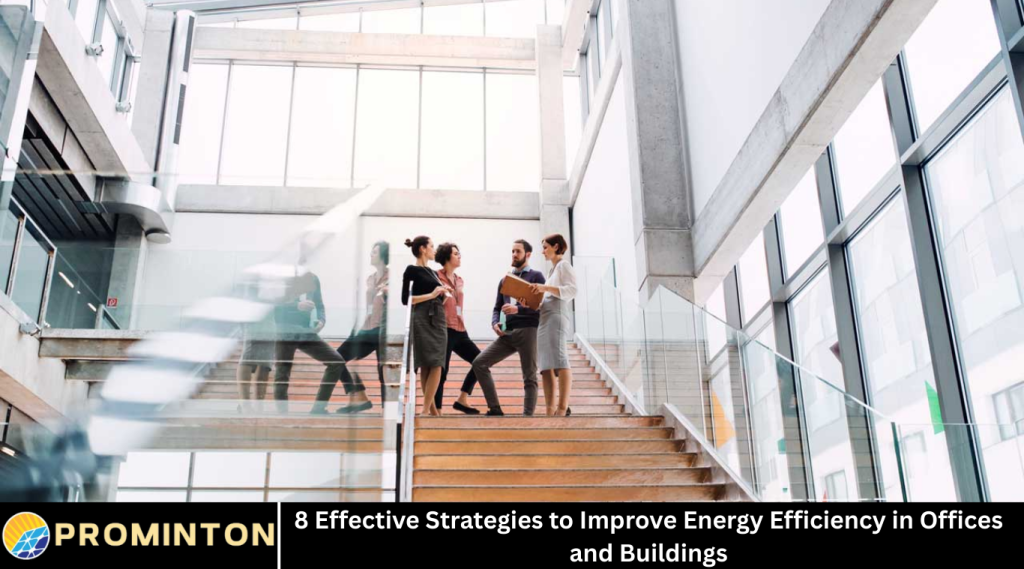Energy efficiency in offices and buildings is becoming increasingly important. With rising energy costs and growing concerns about climate change, businesses and building owners are looking for ways to reduce energy consumption. Improving energy efficiency not only lowers utility bills but also reduces the environmental impact of buildings.
Buildings account for a significant portion of global energy use, so making them more efficient can lead to substantial savings and a healthier planet. This article explores eight effective strategies to make offices and buildings more energy efficient. These strategies are practical and can be applied to both new constructions and existing buildings.
Understanding Energy Efficiency in Buildings
Energy efficiency means using less energy to perform the same tasks or services. In buildings, this can involve better insulation, efficient lighting, smart controls, and renewable energy sources. The goal is to reduce energy waste and improve comfort for occupants.
An energy-efficient building is designed or retrofitted to use energy wisely, minimizing unnecessary consumption. This benefits businesses by lowering costs and improving employee productivity and well-being.
Upgrade Lighting Systems
Lighting is one of the biggest energy consumers in offices and buildings. Switching to energy-efficient lighting systems can significantly reduce electricity use.
LED lights are a popular choice because they use less energy and last longer than traditional bulbs. Installing motion sensors and timers can ensure lights are only on when needed. Natural daylight should also be maximized through window placement and design to reduce dependence on artificial lighting.
Improve Insulation and Building Envelope
A well-insulated building keeps heat inside during winter and outside during summer. This reduces the need for heating and cooling systems, which are major energy users.
Upgrading insulation in walls, roofs, and floors helps maintain comfortable indoor temperatures. Sealing gaps and cracks around windows and doors prevents air leaks. Using energy-efficient windows with double or triple glazing also improves the building envelope.
Use Energy-Efficient HVAC Systems
Heating, ventilation, and air conditioning (HVAC) systems consume a large portion of energy in buildings. Replacing old HVAC units with energy-efficient models can lead to substantial savings.
Regular maintenance of HVAC systems ensures they operate efficiently. Programmable thermostats and smart climate control systems allow buildings to adjust temperature based on occupancy and time of day, avoiding unnecessary energy use.
Implement Smart Energy Management Systems
Smart energy management systems use sensors, meters, and software to monitor and control energy use in real-time. These systems provide data on where energy is being consumed and identify opportunities for savings.
Automated controls can adjust lighting, heating, and cooling based on occupancy and external conditions. This helps prevent waste and improves overall building performance.
Optimize Office Equipment and Appliances
Many office devices and appliances consume energy even when not in use. Encouraging employees to turn off computers, printers, and other equipment when idle can reduce energy waste.
Using Energy Star-rated equipment ensures appliances meet energy efficiency standards. Power management features on devices can automatically reduce energy use during inactivity.
Incorporate Renewable Energy Sources
Integrating renewable energy like solar panels or wind turbines can reduce reliance on fossil fuels and lower energy bills. Solar panels can be installed on rooftops or nearby land to generate clean electricity.
Using renewable energy helps buildings reduce their carbon footprint and often qualifies for government incentives or tax credits.
Promote Sustainable Behavior Among Occupants
Energy efficiency is not only about technology but also about people. Educating employees and building occupants on energy-saving practices encourages responsible behavior.
Simple actions like turning off lights, closing blinds to reduce heat gain, and reporting equipment issues can make a big difference. Creating a culture of sustainability leads to continuous improvements.
Conduct Regular Energy Audits
Energy audits involve a thorough assessment of a building’s energy use and identifying areas for improvement. Professional auditors use tools to measure consumption and evaluate equipment performance.
Regular audits help track progress, verify savings, and prioritize upgrades. They are essential for maintaining and enhancing energy efficiency over time.
Frequently Asked Questions
What is energy efficiency in buildings?
Energy efficiency in buildings means using less energy to provide the same level of comfort, lighting, and services by reducing waste and optimizing systems.
How can upgrading lighting systems save energy?
Energy-efficient lighting like LEDs uses less electricity and lasts longer. Using motion sensors and maximizing daylight reduces the need for artificial lighting.
Why is insulation important for energy efficiency?
Good insulation keeps indoor temperatures stable, reducing the need for heating and cooling, which are major energy consumers in buildings.
What role do smart energy management systems play?
They monitor and control energy use in real-time, automatically adjusting lighting, heating, and cooling based on occupancy and conditions to save energy.
How does renewable energy benefit office buildings?
Renewable energy sources reduce dependence on fossil fuels, lower energy bills, and decrease the building’s carbon footprint.
Can occupant behavior really impact energy efficiency?
Yes, occupant habits like turning off unused equipment and conserving energy contribute significantly to overall savings.
How often should buildings have energy audits?
Regular audits, at least every few years, help identify new opportunities for energy savings and ensure systems perform efficiently.
Conclusion
Improving energy efficiency in offices and buildings is essential for reducing costs and protecting the environment. By upgrading lighting, enhancing insulation, using efficient HVAC systems, and adopting smart technologies, businesses can make a significant impact.
Energy efficiency is a win-win solution, benefiting both businesses and the planet. Implementing these strategies will lead to comfortable, productive workplaces while lowering energy consumption and expenses.



